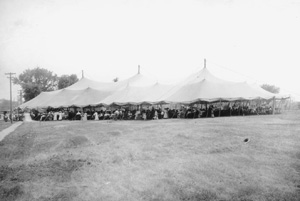CHAUTAUQUA

Chautauqua tent, Kearney, Nebraska, ca. 1890
View largerBeginning in the late nineteenth century, first communities and then touring companies presented a combination of public humanities and entertainment programs that were labeled Chautauquas. The term originates from the educational seminars held first in 1874 at a site near Chautauqua Lake in southwestern New York State.
The Chautauquas that appeared in the Great Plains borrowed the name but drew greater inspiration from the public lyceums that had spread from New England through much of urban America before the Civil War. Chautauqua organizers hoped to bring education and intellectual stimulation to their communities. Scholars, actors, speakers, and exhibits dominated the typical program. The Chautauquans presented plays, reenacted historic speeches, and offered lectures on topics of general interest. They shared the stage with politicians as well, who used Chautauquas to reach a wider public.
The first Chautauquas were held during the summer months in the Great Plains after 1880 and came about through the work of local community leaders. Often, many of the first community organizers had become familiar with the Chautauqua Literary and Scientific Circle (CLSC). The CLSC, which began in 1878 and had more than 2.5 million members by 1900, was a study program designed to bring educational opportunities and enlightenment to individuals who lacked the chance to gain an education through traditional avenues. At first the community-based Chautauquas copied the New York Chautauqua Institute. A combination of professionals and locals provided the talent. Community leaders organized financial support. Larger communities that could afford to hire more recognized per formers and presenters such as Carry Nation and William Jennings Bryan attracted large crowds.
Attempts were made by different Chautauqua groups across wider regions to coordinate their organization, fund-raiding, and scheduling of program content. Disagreements between local promoters undermined these efforts. Private companies that offered packaged programs appeared after 1900. These companies coordinated the performers and the themes and then booked their Chautauquas in strings of communities. The standard Redpath Chautauqua, developed by the Redpath Lyceum Bureau in 1904, was one of the first to tour parts of the Great Plains. By 1919 community organizations typically relied on one or more circuit Chautauqua companies to provide programming.
The circuit Chautauquas provided a wider variety of presentations. However, competition from motion pictures and radio reduced popular support for Chautauquas. Improved transportation, in particular, the spread of automobiles, made it easier for consumers to seek out entertainment rather than wait for it to appear as part of a touring program. While a collection of communities maintained their Chautauquas into the 1930s, the Great Depression undermined what financial and popular support remained.
A modern revival of the Chautauqua form, with scholars representing historical characters, began in North Dakota in 1974. In this incarnation, Chautauquas serve as a public humanities program. A consortium of humanities councils sponsors a touring Chautauqua in the Great Plains each summer. The content and the characters presented, organized around a central theme, change each year.
Daniel Lewis California State Polytechnic-Pomona
Case, Victoria, and Robert Ormand Case. We Called It Culture: The Story of Chautauqua. Garden City NY: Doubleday and Co., 1948.
Harrison, Harry P., as told to Karl Detzer. Culture under Canvas: The Story of Tent Chautauqua. New York: Hastings House Publishers, 1958.
Tapia, John E. Circuit Chautauqua: From Rural Education to Popular Entertainment in Early Twentieth Century America. Jefferson NC: McFarland and Co., 1997.
Previous: Center for Great Plains Studies at the University of Nebraska-Lincoln | Contents | Next: Cliffs Notes
XML: egp.edu.012.xml
